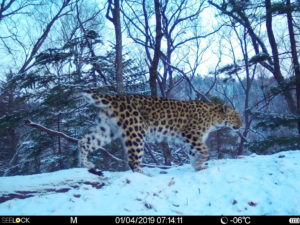In this unprecedented time of lockdown, conservationists are contemplating the future. Here Dale Miquelle, of WCS Russia wonders whether the Amur leopards are enjoying a forest devoid of human presence or not. Only time will tell as his team waits to get back to leopard country.
Coronavirus in Leopard Country: Quiet Streets, Calm Forests?
Vladivostok seems empty these days. The Wildlife Conservation Society’s office in the Russian Far East is based in this vibrant Russian port city, which is an easy three-hour drive to the city of Hunchun, China, or a two-hour flight from Seoul, South Korea. In recent years, drawn by visa-free entry and an inexpensive vacation, downtown Vladivostok has seen a surge of tourists from these countries. As coronavirus evolved from a Chinese issue to a global one, however, Russian President Vladimir Putin first closed down the border. And now, as with other parts of the world, social distancing, closure of schools, and restaurants and a host of other restrictions are the norm. No one is allowed to leave their homes except to buy groceries or conduct other essential business, and no one can enter or exit the city without permission. Vladivostok is now eerily quiet. Our administrative staff in the city meet by Skype several times a week while working from home. The pandemic has pulled our staff apart physically, yet there is a unique sense of camaraderie as we endure this event together.
The low hills of Southwest Primorye can be seen from Vladivostok, at its closest point less than 10 kilometers across the Amur Bay. It is comforting for me to know that in those hills critically endangered Amur leopards roam freely. In fact, these hills, and adjacent hills of nearby China, are the only places Amur leopards can be found. I can see them in my mind’s eye, and I am hopeful that, as in Vladivostok, there are fewer people wandering those hills now, providing the cats some months of tranquillity. Most of what we can see across the bay is part of Land of the Leopard National Park, so there should not be people in those forests without permission. But, as elsewhere across the world, the pandemic is reducing the capacity to patrol protected areas, and poachers may be using the opportunity to their advantage.The lockdown has tied our hands, so we seek alternative ways to help. We have collected recommendations from around the world intended to better protect rangers from the virus; e.g., how do you handle a poacher who is potentially infected? We have organized and translated recommendations into Russian, gotten feedback from several sources, and are sending these out to Directors of Protection at the parks and reserves where we work. And of course, we will post these recommendations on our site, and in other prominent sites in Russia. It is not much, but it is something – a token of our concern for the wildlife, and for the people who dedicate their lives to protecting these endangered cats.
On our side of the bay we sit in grey apartment buildings, waiting for the storm to pass. On the other side the Amur leopards continue their lives oblivious to our chaos, fear, and uncertainty, perhaps basking in the sun of an early spring or stalking Sika deer in peace.
As in the past 18 years, we have camera traps out in those hills, set up in January, as part of an effort to monitor the Amur leopard population. Normally, in late May we would be out pulling the 100+ cameras scattered across a large segment of big cat habitat. Those forests are probably one of the safest places we could be during this pandemic, but ironically, it is not clear we will be able to get to them given the travel restrictions.
Eventually however, we will return to retrieve the cameras, which will help us estimate the abundance of leopards in this unique corner of the world. The Amur leopard population has rebounded dramatically since the creation of Land of the Leopard National Park. It would be a shame if one of the consequences of the pandemic were a dramatic increase in poaching, wiping out the impressive recovery of this isolated leopard population. It is a terrible thought, but it is the reason we have a monitoring system in place – to provide us the information, good or bad.
We wait for the opportunity to return to the forests, collect our cameras, and find out what they tell us about the fate of Amur leopards. Will they prosper in the relative absence of humans, or, because of poaching, become another tragic statistic of the pandemic? Time will tell. Until then, let’s hope the leopards are enjoying our absence.


